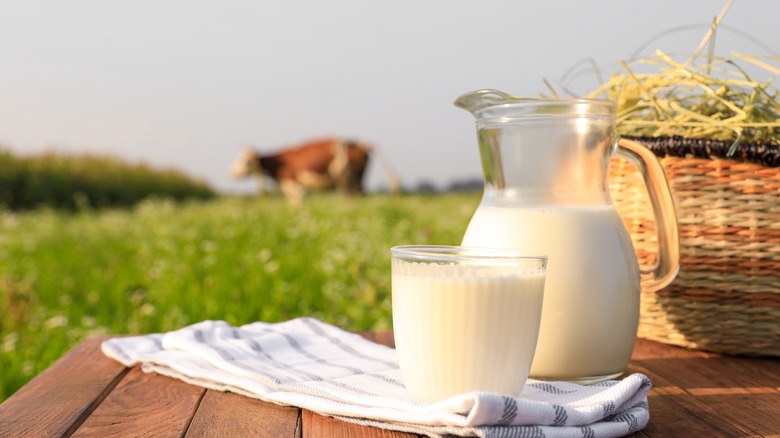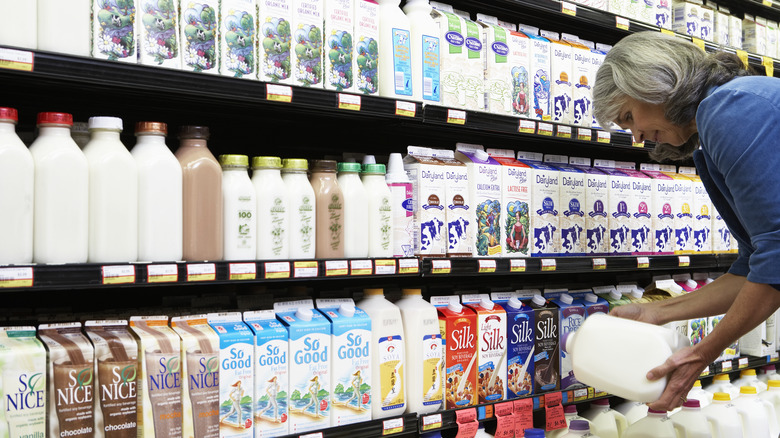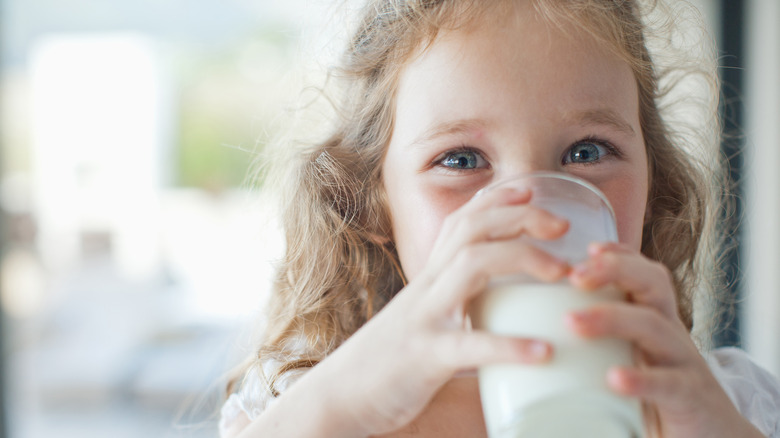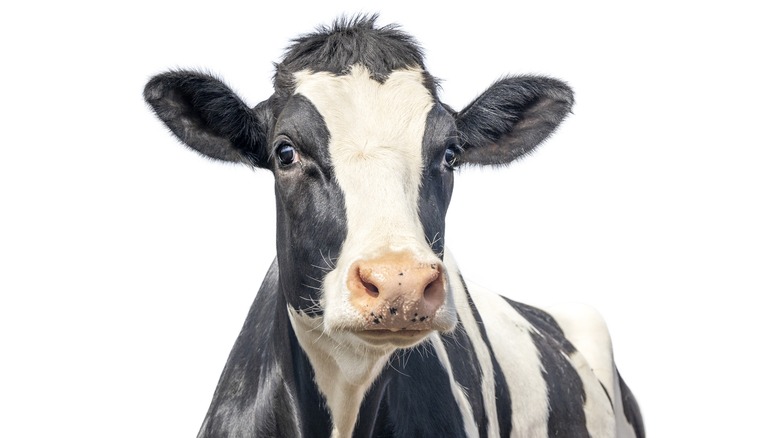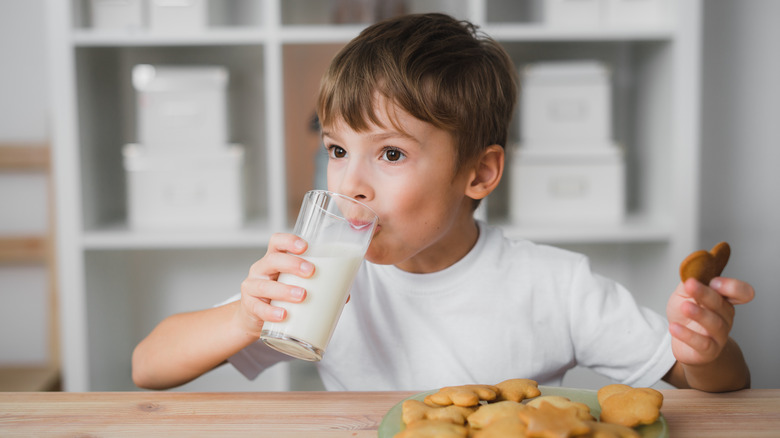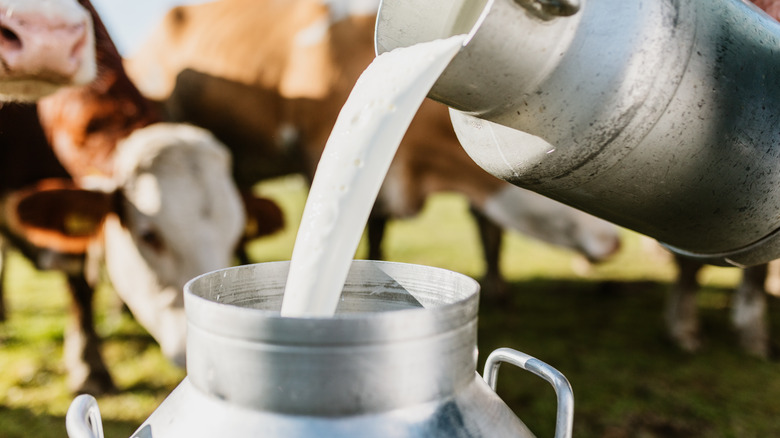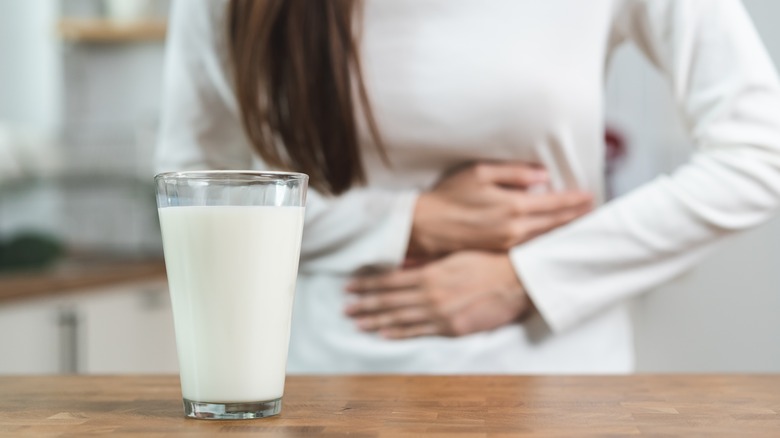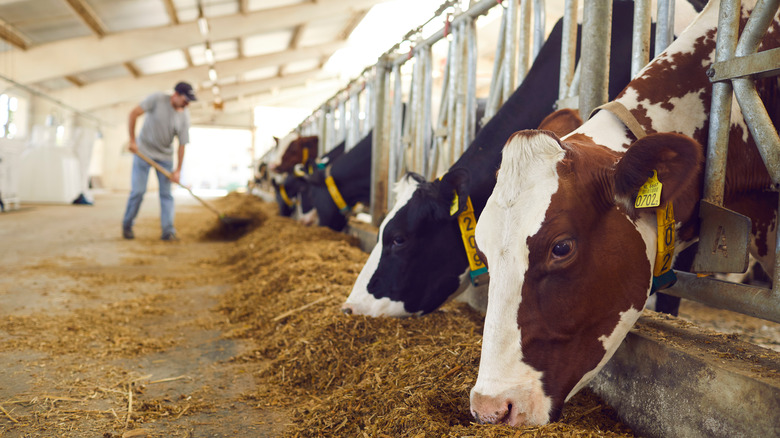Lies About Milk We Can Now Stop Believing
Milk, particularly cow's milk, has been a staple of the human diet for thousands of years. And there's a good reason why: Dairy products are incredibly nutritious. While cow's milk is composed of 87% water, the other 13% of the white stuff is packed with calcium, protein, potassium, phosphorus, and vitamins B2 and B12 (via Harvard University). These days, milk is also usually fortified with vitamins A and D to help prevent nutrient deficiencies.
Despite its numerous health benefits, milk sometimes gets a bad rap. Beyond concerns related to the ethics of dairy farming, some individuals blame milk consumption for a variety of undesirable health issues, from digestive discomfort and weight gain to kidney stones. In reality, for individuals who are neither lactose-intolerant nor allergic to dairy, most of these assertions lack scientific support. Conversely, dairy's health benefits have also sometimes been exaggerated.
From farming and production methods to its impact on health, milk has been the subject of continuous scrutiny and frequent misinformation. Are you ready to find out the truth? Here are 12 common lies about milk we can now stop believing.
Lie: We need to drink milk to maintain healthy bones
We've probably all been told this as children — drinking milk builds strong bones. And there's truth in that since milk contains calcium, which is commonly linked with promoting healthy bones and teeth, per the National Institutes of Health. We all need a certain level of calcium in our bodies, depending on our age and sex. Older kids need a lot of calcium, as do middle aged and elderly people. While a six-month-old baby needs only 200 milligrams of calcium per day, individuals over the age of 50 should aim for a daily calcium intake of 1,200 milligrams.
Whole milk contains calcium, but it's by no means the only source of the beneficial mineral — and we are not just talking about other dairy products, such as cheese and yogurt. Leafy greens are also a great source of calcium. For instance, one cup of cooked collard greens provides 269 milligrams of calcium, while a cup of cooked spinach offers 245 milligrams, and a cup of cooked kale supplies 177 milligrams. For comparison, a cup of 1% fat milk comes with 305 milligrams of calcium. Some other calcium-rich foods include sardines, tofu, black beans, and almonds.
While we definitely need calcium for bone growth and better bone density, some research suggests that drinking too much milk can actually have a detrimental effect on our health. According to one study, drinking more than three glasses of milk a day can actually increase the risk of fractures and death (via NCBI).
Lie: Skim milk is just watered down milk
Also sometimes called fat-free or non-fat milk, skim milk has had its fat content completely removed. To put things in perspective, whole milk is around 3.5% fat and reduced-fat milk is around 2%. For case of reduced-fat milk, the manufacturing process involves separating out the cream (just like in skim milk) but some of the fat is then added back into the mix.
Since whole milk is thicker and whiter in appearance than milk that has had its fat stripped or reduced, it's easy to assume that the lighter milk versions are just watered-down whole milk. This, however, couldn't be further from the truth. Skim milk contains exactly the same nutrients as whole milk minus the fat. However, while whole milk has approximately 150 calories per 8-ounce glass, for skim milk this number stands at 80 calories per glass. Meanwhile, low-fat milk has around 120 calories per glass.
Lie: Drinking milk will make you fat
As we've covered, milk is sold with several different levels of fat, each of which has a different calorie count. If you're really concerned about your fat and calorie intake, you can always opt for skim milk. However, even those trying to shed excess pounds with a taste for whole milk shouldn't be overly concerned about indulging in the dairy.
The fat in whole milk is what makes the product filling. This sense of fullness can help curb appetite and potentially lead to reduced calorie intake, which definitely makes sense when it comes to weight loss. Milk also contains carbs, which not only help the body function but also provide energy. According to a study published in Nutrients, incorporating dairy into a limited-calorie diet increased weight loss and fat reduction. Another study from The New England Journal of Medicine, however, found that consuming milk had no effect on either weight loss or gain.
Lie: Kids need milk to stay healthy
Humans need calcium to grow and maintain healthy bones. Traditionally, children have been encouraged to drink milk to facilitate bone growth. And it's true that kids between 9 and 18 years of age require the greatest amount of calcium — 1,300 milligrams. This recommended daily calcium intake decreases to 1,000 milligrams for adults between 19 and 50 years of age.
Many say that the importance of milk consumption among children has been overhyped. According to the Physicians Committee for Responsible Medicine, babies don't need any form of milk once they have transitioned from breast milk or formula. One study has gone so far as to establish a connection between childhood milk consumption and colic (via PubMed). This being said, milk is an amazing source of calcium, protein, and vitamins. However, these nutrients can also be easily found in other food sources, such as beans, leafy greens, and nuts.
Flavored milk consumption among children is a potential health risk as well. While still a source of some essential nutrients, flavored milk comes with added sugars and artificial flavors, which can have negative health implications for children, such as obesity and dental problems. Amy Lanou, a professor of nutrition at the University of North Carolina at Asheville, is highly critical of flavored milk, saying, "An 8-ounce glass of low-fat chocolate milk has the same number of calories from sugar as an 8-ounce glass of Coke or Pepsi" (via LiveScience).
Lie: Milk is packed with growth hormones
All milk contains trace amounts of bovine growth hormone (BGH), also referred to as bovine somatotropin (BST). This is because BGH is naturally produced by cattle to regulate various physical processes, including milk production. Some farmers use a synthetic replica of this hormone called recombinant bovine somatotropin (rBST) to increase milk production on their farms.
While some are up in arms about the potential dangers of rBST, tests have shown that milk from bovine treated with rBST is indistinguishable from milk that has been administered the hormone. More specifically, 90% of rBST is destroyed during the pasteurization process while the remainder is completely broken down during digestion. Those concerned about milk from cows treated with rBST can opt for rBST-free milk. All it takes is a quick look at the product's label. Per Gonna Need Milk, some of the phrases to look for on the milk carton include "rBGH-free milk," "rBST-free milk" or "from cows not supplemented with rBST."
Lie: Milk can lead to early puberty
Based on research findings, puberty is beginning at progressively earlier stages (via ScienceDirect). While the exact reasons for this phenomenon are unknown, some have attributed this trend to hormones in milk. More specifically, it has been suggested that the administration of recombinant bovine growth hormone (rbGH) to some cows to boost their milk production may be linked to early puberty.
Numerous studies have since refuted the notion that the minuscule amounts of growth synthetic hormones in milk trigger early puberty, per VeryWell Family. Firstly, the amount of growth hormone in milk produced by cows treated with rbGH and cows not treated with the hormone is approximately the same. In addition, any small amounts of the hormone in the milk are neutralized in the digestive tract. Furthermore, a study in Karber found that growth hormone differs from estrogen in that it has no influence on sexual development.
So what's the reason for the early onset of puberty in children? Two contributing factors identified by a number of studies include better nutrition and a growing incidence of obesity in kids. Another factor to consider is exposure to estrogen-mimicking chemicals found in some common products such as plastics and even lotions and toothpaste (via Psychology Today).
Lie: Milk is filled with pus
The misconception that milk is packed with pus likely stems from a misunderstanding of some aspects of the dairy industry. When appropriately collected and processed, milk contains minimal amounts of pus (a mixture of dead white blood cells, skin cells, and bacteria). NutritionFacts.org estimates the actual amount of pus in a cup of milk to be around a drop or less. Pus is a normal part of cattle's immune system and is often produced due to mastitis, a condition where the udders become infected.
While the levels of pus in milk are minuscule, milk does contain somatic cells, a substance primarily composed of white blood cells. The amount of somatic cells present in milk is used to assess the product's quality, with a high somatic cell count indicating that the cow is likely to be battling an infection. To ensure that consumers receive the best possible quality of milk, governments have implemented restrictions on the allowable somatic cell counts in milk products available for commercial sale. In the States, grade A milk can't contain more than 750,000 somatic cells per milliliter. Conversely, the European Union, Canada, Australia, and New Zealand have set a lower limit of 400,000 cells per milliliter for somatic cell counts in milk intended for human consumption. Essentially, this means that a significant portion of milk in the U.S. is of lower quality than in these countries.
Lie: Milk increases mucus production and congestion
Some people believe that drinking milk can increase the production of phlegm or mucus, a substance made by the respiratory system that can become particularly bothersome when we have a cold. It's sometimes said that this belief dates back to the 12th century when Jewish court physician Moses Maimonides noted in his "Treatise on Asthma" that milk causes a "stuffing in the head" (via Disease in Childhood). The idea that milk causes congestion was described in the influential "Baby and Childcare" book by Dr. Spock, first published in 1946. Interestingly, this idea was still mentioned in the edition of the book published in 2011.
Today, the belief that milk causes phlegm persists despite an absence of scientific evidence supporting this connection. In fact, studies have found that there's no link between milk consumption and congestion. For instance, a study published in the Journal of the American College of Nutrition found that drinking milk made no difference to mucus production in people with the common cold. Some experts have said that the misconception that milk causes mucus can be attributed to our perception. This is because mixing milk with saliva can generate a sensation of thickness that coats the mouth and throat in a similar way to phlegm.
Lie: Lactose intolerant people can't drink milk
Lactose intolerance refers to the body's inability to effectively digest the sugar found in milk and dairy products, known as lactose. While individuals with lactose intolerance may sometimes experience symptoms such as bloating and cramping after consuming dairy, this isn't always the case. The reality is that people suffering from lactose intolerance can usually consume certain amounts of milk without any or few symptoms. It's important to highlight that this applies to people with lactose intolerance and not milk allergy, which is an immune response triggered by the proteins found in milk.
When it comes to lactose intolerance, everybody has a different tolerance level. This is why it's important to experiment to discover your individual threshold when it comes to the amount of milk you can drink without getting sick. WebMD suggests completely abstaining from dairy for two weeks and gradually bringing it back into your diet to see how your body reacts to the lactose. Alternatively, lactose-intolerant individuals can replace regular milk with lactose-free milk, which usually contains the same nutrients as regular milk.
Lie: The naturally occurring sugar in milk is bad for you
Milk naturally contains a sugar called lactose, which is the product's main source of carbs. In fact, an 8-ounce up of cow's milk contains around 12 grams, or three teaspoons, of sugar. Skim milk may contain slightly higher levels of lactose than whole milk because when the fat is removed from the milk, the remaining sugar becomes a little more concentrated. We normally don't perceive milk as being sweet because the table sugar we are used to is around six times sweeter than lactose.
Unlike added sugar, which is merely empty calories, naturally occurring lactose contains nutrients that help prevent blood sugar spikes and unpleasant crashes, per Integris Health. This is because milk also contains protein, which requires more time to break down and mitigates sudden spikes in blood sugar levels. Additionally, our bodies convert lactose into glucose and glycogen, providing us with the energy needed for our daily activities. Conversely, other types of milk such as rice, soy, or almond milk, usually contain added sugar to enhance their flavor and make them taste sweeter. The same applies to flavored milk, which is often sweetened with added sugar.
Lie: Milk contains antibiotics
The misconception that milk may contain antibiotics stems from a misunderstanding of the milk production processes and regulations. In fact, milk stands as one of the most rigorously regulated food products available. Just like humans, cows that fall ill are given antibiotics. However, these medications can only be prescribed by a licensed vet. Furthermore, sick cows are isolated from the rest of the herd during treatment, and they can only rejoin the herd once they have fully recovered and the antibiotics have completely cleared from their systems.
To ensure that it's completely antibiotic-free, all milk is tested three times before it's cleared for consumption. Firstly, dairy farmers test their milk for traces of antibiotic residue directly at the dairy farms. The second test is conducted by the driver of the tanker that picks up the milk. Finally, the third test takes place at the processing plant — this test not only looks for antibiotic residue but also other factors such as milk fat and protein content. If the milk fails to meet the required standards, the entire tanker of the contaminated product is discarded without the farmer receiving any compensation. According to the National Milk Drug Residue Database, in 2021, only 451 out of nearly 4 million tested shipments of milk came back positive for drug residue.
Lie: Drinking milk can lead to kidney stones
Kidney stones are a relatively common complaint. Each year, one in 500 Americans is diagnosed with the medical condition (via the University of Florida). And since the hard deposits of minerals and salts can cause significant pain and discomfort, it's only natural that most people will do everything in their power to avoid them. Unfortunately, for some people, this means abstaining from milk.
Since the most prevalent kind of kidney stone is called calcium oxalate, many people mistakenly believe that it's caused by consuming calcium. In reality, this couldn't be further from the truth. Drinking milk and consuming calcium-rich foods, such as cheese and yogurt, actually reduces the risk of kidney stones. This is because the calcium in milk binds to oxalate before reaching the kidneys, making kidney stones less likely (via the University of Guelph).
Oxalate is found in a wide range of foods, including fruit, vegetables, nuts, seeds, legumes, and grains. As such, individuals who suffer from kidney stones may wish to limit the consumption of these products. Alternatively, they can also eat calcium-rich products, such as milk, during meals to increase the chances that the calcium in the milk and oxalate bind together in the stomach and intestines before reaching the kidneys. Notably, while calcium that occurs naturally in food can reduce the risk of kidney stones, the same can't be said for calcium supplements, which have been linked with an increased risk of the condition, per Let's Eat Healthy.
